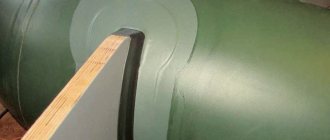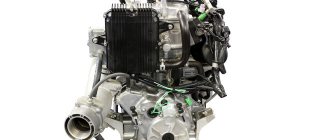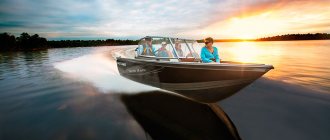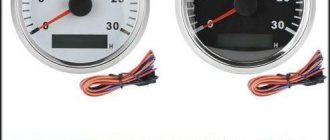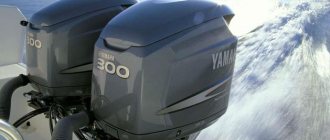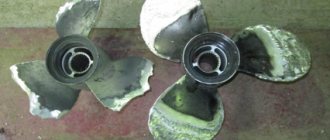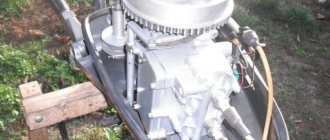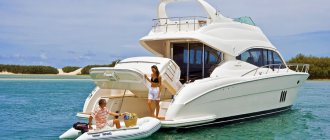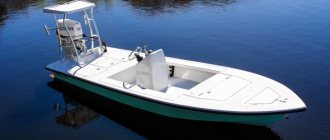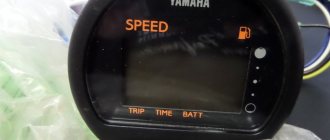How to properly install a motor on a boat transom
Motorka.PRO store specialist Maxim Ostapenko discusses the intricacies of installing a motor on the transom: immersion depth, trim angle - and explains how the boat’s performance changes.
After purchasing a boat motor, people often install it on their boat as is. In most cases, if the motor and boat match, that's enough.
But it happens that the boat cannot go into planing mode due to improper installation of the motor .
It is very important to maintain the correct trim angle and immersion depth of the propeller relative to the boat. There are special devices for this.
And if the trim angle is adjusted on the motor itself: using a special bar and holes on the motor mounting clamp or using a motor hydraulic lift ,
then the immersion depth of the screw must be adjusted using additional special devices. It's good if your boat is equipped with a height-adjustable transom, but, as a rule, small fleets do not have this option.
transom extensions come to the rescue ; there are also transom overlays for quickly adjusting its height. The easiest way is a pair of wooden blocks of small thickness.
What is the essence of proper engine installation?
The fact is that the motor must stand at a right angle to the plane of the water and be immersed below the bottom of the boat by 2-3 centimeters relative to its anti-cavitation plate .
Why is this being done?
Trim is necessary to keep the boat horizontal .
If the motor is at an angle to the water, then the boat will either bury its bow , if the motor is tilted towards the transom ,
or vice versa, lift the nose if the motor is strongly tilted outward from the transom .
How to install an outboard motor on a PVC boat - a little theory and safety rules
Knowing a few simple rules and following general recommendations regarding the installation of PLM on an inflatable PVC boat will allow its owners to achieve optimal results in both operating comfort and speed performance.
You can install a small PLM on the transom yourself, but for the first time it is better to involve an assistant in this matter. Most importantly, do not ignore the manufacturer’s instructions, which contain a detailed description of the process. Violation of the instructions can result in serious consequences - loss of control when accelerating or braking, while driving or turning. Forced unwanted swimming and pulling a sunken ship out of the water is the least of all possible evils. In a worst-case scenario, the engine may catch fire, the vessel may be lost, and passengers may be injured.
IMPORTANT - any installation or adjustment work is carried out only with the engine turned off!
Correct installation of the motor on a PVC boat guarantees high performance, so it would be advisable to approach this issue scrupulously and responsibly. The following points must be taken into account:
- Cavitation effect. The process of formation and further collapse of air bubbles in a fluid flow, accompanied by water hammer, can cause serious damage to the propeller and outboard motor. An anti-cavitation plate is designed to protect it from gas bubbles.
- Transom mount. This element can be mounted or stationary, and, accordingly, has its own characteristics, advantages and disadvantages that must be taken into account when purchasing a PLM and installing it on a boat with certain technical characteristics.
- Tilt angle. If the motor is not ideally mounted on a rubber boat, its bow may rise too high while moving, or, conversely, sink into the water, reducing the overall stability of the vehicle on the water and threatening to capsize.
Now let's look at the key aspects of engine installation in more detail and from a practical point of view.
How to properly install an outboard motor on a PVC boat?
Installing a boat motor on a PVC boat is an extremely important process in the operation of this convenient watercraft. Its overall performance will depend on how correctly the engine was installed on your boat. After all, a modern outboard motor is distinguished precisely by the fact that it can be easily and quickly installed and dismantled - but done skillfully.
If the installation of the outboard motor was not done entirely correctly, the boat may operate intermittently, and it may even be somewhat stormy from side to side. And, of course, the worst outcome could be an accident.
Useful video
Video review of the first launch of the Tohatsu M9.8 BS outboard motor:
Video on how to “fit” a motor to a boat:
Oars are reliable and practical, but for full movement on water, an inflatable boat requires the installation of an engine. Putting a boat motor on a PVC vessel means giving yourself the opportunity to raft far from the shore. Adventures, pleasant company, a rich catch and, of course, indescribable coastal beauty await the owner of the power plant. Modern engines come in different sizes and weights. This means that you can install an outboard engine on almost any inflatable boat. The tilt-and-turn design of the power plant allows not only rafting in deep water, but also movement in rapids or rocky shallow water.
The FISHERInfo portal will tell you how to properly install a motor on a PVC boat.
The importance of proper outboard motor installation
Why is it so important to install a boat motor correctly? It is not someone's whim that the engine must be very carefully attached to the watercraft - this is the safety standard. There are also other important nuances in installing a boat motor to a watercraft:
- If you have not connected your outboard motor correctly, then even random disconnection of the outboard unit may occur, which can lead to certain emergency situations. Your small boat may lose its direction. That is, you will try to taxi in one direction, but the boat will stubbornly tilt in a completely different direction;
- Also, incorrect installation of the motor on the transom of the boat may result in the engine not operating at full capacity. The most common occurrence is that your outboard motor is under-revving;
- You can also expect consequences such as excessive fuel consumption or even a fall of the boat unit into the water. Remember that when you are still at the stage of selecting an outboard boat motor for yourself, it is important to pay attention to the permissible power rating of the boat engine. This parameter will always be reflected in the instructions for the suspended unit, and in no case should this data be neglected;
- a lot depends on what kind of outboard motor and what brand you purchase. But in general, the data given applies to all units for boats. In addition, the kit that each outboard motor has usually also includes special fasteners, tools and instructions for the proper operation of your outboard unit. It usually has all the correct steps to follow to install an outboard;
- Manufacturers of inflatable boats, as a rule, apply special markings for fastening on the transoms of their boats. At first glance, it seems that all that remains is to install an outboard motor on your boat, but in reality, boaters encounter unforeseen situations. It happens that completely identical boats, from the same manufacturer, with identically installed boat hangers, behave differently in the water. Everything is quite individual, and sometimes it is not enough to follow one instruction; you need to know more real recommendations for the correct installation of a boat engine on a rubber boat.
Proper installation of an outboard motor
Sometimes owners of inflatable motor boats wonder whether it is possible to increase the speed characteristics of their boats with an existing outboard motor. There are several possible answers. You can install a hydrofoil for your outboard motor, or you can simply see if your motor is installed correctly on your boat.
It is impossible to increase driving characteristics, and in particular speed, indefinitely. The motor boat itself imposes a limitation on this indicator. Read the instructions for your boat and see what maximum power outboard motor can be installed on it. And then you can start wondering whether to buy a boat motor or not. Today we will try to get the most out of your existing outboard motor. And the first question is the height of the transom.
Boat transom height
All outboard motors are designed for a specific transom height. Only a motor installed on the correct transom will produce the indicators indicated in its passport. If the outboard motor is installed on a transom that is too high, the propeller will operate at the air-water interface. It will not be completely immersed in water and will capture air during operation. This will greatly reduce the performance of the motor. If, on the contrary, your outboard motor is installed on a low transom, then the flow of water will create unnecessary resistance on the lower part of the motor, and the “shoulder” will also increase, which pushes the bow of the boat, which, if you have a high-power motor, can lead to the boat capsizing.
According to the standard, the outboard motor is installed in such a way that the anti-cavitation plate ( “a” in the figure) is located parallel to the bottom of the boat and 30-50 mm below the bottom. You can, of course, raise the motor a little, which will increase the speed, but then there is a high probability of air being sucked into the propeller. The height of the transom along which the motor is designed ( “b” in the figure) is the distance from the motor mounting point to the anti-cavitation plate.
Outboard motor tilt angle
We have already touched on this topic in a separate article (Tilt angle of a boat motor). Now let's just go over the main points a little.
All outboard motors have a tilt adjustment range.
- foreign boat motors: 5-15 degrees.
- “Breeze”: 0-10 degrees.
- “Whirlwind”: 5-15 degrees.
- “Salyut”: 4-24 degrees.
Before you buy a boat, be sure to ask the seller about the angle of the transom. If the transom angle is below 5 degrees. You can only use the “Veterok” boat motor . Otherwise, the boat will constantly lift its nose. If the angle of inclination of the boat transom is higher than 15 degrees, then only the Salyut motor . All other boat motors will bury the bow of the boat in the water.
A few illustrations on the topic of motor tilt angle.
Proper distribution of cargo in the boat
In addition to the correct installation of the outboard motor on the boat , the correct distribution of cargo in the boat is also important for obtaining optimal performance of the boat. Possible options for cargo distribution and their consequences.
Shifting the load to the stern of the boat.
- speed increase
- the boat will start bouncing on the waves
- being overwhelmed by a wave from the stern
Shifting the load to the bow of the boat.
- soft, smooth ride
- improves stability on waves
- if overloaded, the boat will not hold its course well
Tags
hydrofoil
Important points when choosing
Failure to follow the instructions for installing an outboard motor can cause the following unpleasant situations:
- spontaneous disconnection of the outboard motor;
- deviation of the vessel from the chosen direction;
- the engine is not running at full speed (low speed);
- excessive fuel consumption;
- engine falling into water.
When choosing an outboard motor, you need to pay attention to:
- The value of the permissible engine power - such data is contained in the documentation attached to the water vessel, according to which outboard motors are used.
- To the actual height of the vessel's transom .
- The permissible power range - this parameter is also indicated in the documentation and should not be neglected before purchasing a specific outboard motor model.
Outboard motor location
The first stage of installing an outboard motor is to place it at the stern, maintaining symmetry with respect to the sides of the craft.
Height position:
- The recommended level for placing the anti-cavitation plate is 0-50 mm below the very bottom of the boat.
- You should know that the level of installation of the motor must be selected taking into account the actual purpose of the vessel, as well as the type of its hull. That is why it is necessary to strictly adhere to the specified recommendations of manufacturers of watercraft, which are necessarily described in the attached documents.
- The recommended depth of the anti-cavitation plate is at least 100 mm relative to the water surface. Otherwise, there will be a lack of water flowing through the pump into the cooling system, and this will result in overheating of the outboard motor and subsequent malfunctions.
- If the engine is installed too low, which is unacceptable, this can lead to various mechanical damages.
- When the boat is under maximum load, lower the engine completely and turn it off. When finished, it is recommended to check where the idle air outlet is located. A safe distance is considered to be 150 mm or more in relation to the water level.
Outboard Engine Installation
First of all, you need to understand that all actions aimed at fastening various design elements must be carried out as reliably as possible.
Otherwise, the outboard motor may become detached. To safely lift the outboard for installation, it is recommended to use a so-called gooseneck and to secure the lifting cables using appropriate eyebolts.
Of course, the value used in this case acts as a guideline, since the actual tightening torque of the nuts can differ significantly depending on the hull material of a particular watercraft.
The main stages of installing a motor on a boat are:
- placing silicone sealant in the motor mounting holes;
- installing the motor on the rear of the boat;
- fastening the outboard motor in the right place using special fasteners.
Adjustment
Depending on the dimensions and model of the inflatable boat with a transom, the outboard motor is adjusted in practice. This means that no matter what theoretical skill the boat owner has, only rafting will show how best to hang and secure the power plant.
Tips on how to adjust a boat motor to a PVC boat and how to properly tilt the installation from the transom:
- Turn off the engine and lift it off the transom.
- Remove the stop from the bosom with the limiting comb. There are usually three notches on the ridge.
- Move the pin to the desired position on the comb.
- Start the engine and test the new adjustment.
Adjustment diagram
Possible installation errors
The main thing that must always be remembered is that the optimal angle of inclination depends on the following circumstances:
- on the individual design features of a given boat;
- on the actual characteristics of the proposed outboard motor model;
- on the actual characteristics of the propeller used;
- from the actual operating conditions of the vessel.
First of all, you need to make adjustments regarding the position of the motor: its location should be perpendicular to the surface of the water, in this case the axis of the propeller is parallel to the water surface.
At this stage of installation, you should be aware that if the angle of inclination of the boat engine is insufficient, then there is a significant increase in trim on the bow of the vessel. Visually, it looks as if the ship is trying to plunge its nose into the water.
After the work has been done, you need to make sure that the actual angle of inclination of the outboard motor is selected correctly at an already established speed.
If the angle of inclination was determined incorrectly, then this position may cause excessive trim to the stern of the vessel.
The optimally selected tilt angle when installing the outboard motor allows you to operate it at maximum efficient power.
Rules for choosing a propeller
It is a correctly selected propeller that can create the required speed of rotation of the crankshaft of a boat motor, but only on condition that the throttle valve is fully open and the vessel is maximally loaded. Among other things, the actual speed of the motor shaft depends on the size of the propeller and the technical condition of the particular vessel.
If a boat motor, like any other engine, is operated at high crankshaft speeds, this will soon lead to negative consequences that may affect the technical condition of the motor, and then lead to serious malfunctions.
It is a high-quality and optimally selected propeller that significantly extends the service life of the outboard motor.
The ideal propeller is one that allows the engine to develop the recommended number of revolutions at 80% load of the boat. If the maximum speed is reached when the boat is fully loaded, there is a possibility of exceeding the recommended speed when the boat is not fully loaded.
If the engine develops the maximum possible speed when the vessel is not fully loaded, then as the load increases, it will “suffocate.” As a result, underloading and overloading the vessel significantly increases the consumption of the fuel mixture and reduces the distance covered per unit of fuel consumption. This is where the importance of choosing the right propeller comes from.
- Diameter defining the maximum size of the propeller along the blades. In particular, cargo ships use larger diameter propellers, allowing them to feel confident when fully loaded.
- The pitch determines the length of the helical surface, which is formed by the propeller blade per revolution. This indicator is necessary to ensure the conditions for the vessel to move at high speed and, moreover, with economical calculation.
By increasing the propeller pitch at the same engine speed, you can significantly increase the speed of the boat. Such actions not only increase the efficiency of the engine, but also reduce specific fuel consumption.
Increasing the propeller pitch also improves the ship's controllability during high-speed turns. Of course, the material from which the propeller is made is also considered a significant point. In some situations, this is more important than the engine power rating. For engines with a power of 50-110 hp. With. The best option is stainless screws made of aluminum or steel.
So, installing a motor on a boat is a really crucial moment , so in order to avoid unforeseen situations on the water, it is more advisable to use the recommendations of specialists.
Installing a boat motor: once and done?
Installing a motor on a boat is far from a one-time event, as it might seem at first glance immediately after purchasing an aluminum boat. This operation has to be done, for example, after preserving the engine for the winter, prevention or repair, and also, if necessary, installing a second outboard motor (for trolling, careful maneuvers and other tasks).
Why, in general, is it necessary to properly install a motor on a boat? First of all, for the sake of safety - in order to prevent overheating, not to break the screw and not get injured yourself. In addition, no one will refuse to get the most out of their faithful companion, and at the same time avoid her deviations to the side and optimize fuel consumption.
Not everyone can cope with this procedure alone. The reason for this is both the considerable weight of the motor itself and the basic lack of experience, knowledge and necessary skills.
Although, it would seem, there is nothing simpler: there is a transom, and there is a motor. However, there are often cases when the existing engine does not fit properly into its normal place and the transom height needs to be adjusted until it is replaced (in PVC boats). In other situations, you have to resort to installing various stands for the outboard motor.
Further - even more subtleties. An unreasonably low landing leads to a decrease in speed and loss of power, and also poses the risk of damage to the engine leg. It is known, for example, that the resistance of water flow increases at speed, and this process occurs nonlinearly. Accordingly, every millimeter of an excessively submerged engine affects fuel consumption and speed of movement.
On the contrary, installing the motor too high on the transom provokes the formation of a large number of bubbles in the upper layer of water (this is why it is important to correctly set the level of the motor cavitation plate). As a result, the propeller rotates in a more rarefied environment, increasing the number of revolutions, which leads to overheating of the engine.
However, during installation, not only the height is taken into account, but also the horizontal position on the transom and the angle of inclination of the outboard motor. So, the theory says that the engine should be shifted a few centimeters to the starboard side to compensate for torque. However, in reality, many factors must be taken into account, such as: bottom profile, load distribution, engine size and weight, weight of the boat itself, propeller type, etc. – they all influence the choice of installation location for the motor. Often, inexperienced boat owners spend a lot of time searching for the optimal position and, at best, maintain the status quo.
All of the above are basic principles that only allow you to correctly install the motor on the boat. But sometimes you want more comfort, and then tasks such as:
installing a tachometer on a boat motor;
remote control of boat motor;
installation of an electric lift on a boat motor;
installation of other indicators on the boat console (fuel level, trim meter, speed, voltmeter, etc.).
The final fine-tuning depends on the scope of use of the boat (cruising, recreational fishing, competitions) and its intended load, so after installing the motor, more precise adjustment of its position and selection of the correct propeller will almost certainly be required. There is a high probability that the standard pitch and material of the latter will not allow achieving the required conditions. And here you definitely can’t do without the advice of professionals who have tested hundreds of different combinations of boats, motors and propellers.
By the way, don’t forget about the bow electric motors. They are also installed and adjusted by the mechanics of our service center at the request of the owner. And for those who still prefer independent experiments, a variety of electric lifts can be offered as a useful tool - even hydraulic lifts for particularly powerful motors (200-300 hp). They are able to dynamically raise/lower the engine to find the optimal speed and change the trim to improve the boat's performance, as well as facilitate movement in shallow water and ensure safe launching. At the same time, detailed adjustments are available directly from the driver’s console using a special remote toggle switch.
As you can easily see, when installing the motor correctly on a boat, a few millimeters and degrees are decisive, and it is quite obvious that beginners are not recommended to engage in such tuning. Otherwise, there is a high risk of losing control of the vessel, drowning the engine, or, even worse, injuring yourself and passengers.
Many clients have already been convinced of the professionalism of Prokatis.ru employees, who know exactly how to polish any boat and turn it into the model of your dreams. Moreover, with high quality, in the shortest possible time and at a very reasonable price.
We are waiting for applications at our service center. We still have many interesting ideas!
What you need to know before installing your outboard
For most people, installing an outboard motor on a boat seems simple. Like, it’s not a big task to just hang the engine on the stern. But with this approach, frankly speaking, you won’t get far on the ship: lists will appear and problems with the operation of the propeller will begin, leading to excessive fuel consumption. As a result, the craft will constantly go off course, and a motor incorrectly installed on the transom of an inflatable boat will simply not be able to produce the maximum speed stated by the manufacturer. Moreover, an insufficiently stable ride is not so bad: in some cases it can lead to engine failure and vessel breakdown.
To avoid such troubles, you should mount the motor to the transom of the boat in compliance with all the recommendations of the boat manufacturer, and additionally adjust the boat engine to your PVC boat. A little later we will look at how these actions are performed in practice, but for now we will arm ourselves with the theoretical information that will be needed to understand the intricacies of the procedures. So, before you put an outboard motor on board a small boat, you need to have a clear understanding of the following points.
Built-in and mounted transoms
Transom height and mounting
Let's start with the base on which the outboard motor is mounted, i.e. from the transom. It can be mounted, i.e. used optionally, or built into the hull of the vessel. Installation of the transom board is carried out in several ways:
- Fixation with rigid fastenings at the stern (fraught with dependence on the filling of the cylinder: when the pressure decreases, the motor on the transom begins to “walk”);
- The use of plastic eyelets for fastening to the stern (more relevant than option 1);
- Gluing PVC plates and lacing (ensures reliable fixation of the PLM);
- Installation of fastenings on the sides and at the bottom (increases structural rigidity, used for high-power engines).
As a result, the transom fixation must be reliable enough so that the boat engine does not “walk” and, moreover, does not break.
You should also pay attention to such factors as dimensions, and the height is of particular importance for installing a boat motor on the transom. The immersion depth of the propeller, which is responsible for the proper operation of the engine, depends on it. As a standard, PVC boats have a height of 381 mm for installing the motor on the transom: this value is sufficient for proper installation and individual adjustment of the height and tilt of the PLM.
The optimal transom height is 381 mm for installing a boat motor
Correct position of the outboard motor
Traditionally, the installation of a motor on the transom of an inflatable boat is carried out along the central or keel axis of the vessel. This arrangement is optimal for the operation of most vessels.
However, it should be taken into account that the propeller of an installed outboard motor during operation creates a strong vortex flow, which can slightly lead the vessel off course. Therefore, it is sometimes recommended to shift the engine, depending on the direction of operation of the propeller, to the right or left side by a distance of up to 5 cm (for boats with a flat bottom up to 3 cm). It is believed that such placement will improve the ship's handling and ensure course stability. Nevertheless, there are few reliable reviews about the practical benefits of shifting the PLM, so we recommend using this solution only when there is a really noticeable roll of the boat to the side.
Also note that some vessels are already designed to take into account the influence of propeller torque. In this case, the correct installation of the motor on a PVC boat is carried out strictly in accordance with the recommendations of the manufacturer of the watercraft.
Cavitation and motor height adjustment
When installing a motor on a PVC or rubber boat, we must also take into account the phenomenon of cavitation. It arises due to the operation of the propeller and represents the formation of gas bubbles in the water flow, and then their subsequent bursting, in turn causing the appearance of shock waves. Thus, the cavitation process harms the outboard engine in two ways:
- The action of the hot gas, which spreads from the bubbles, causes damage to the body.
- The shock waves that appear from the collapse of bubbles add extra load and contribute to rapid engine wear.
You may be interested: Outboard motor tax - tax rates by region, calculator
The anti-cavitation plate designed to protect the propeller and the correct installation of the outboard motor on a PVC boat help relieve owners of motor boats from such problems. An anti-cavitation plate mounted on the sternwood prevents the propeller from capturing air, therefore preventing the occurrence of cavitation in advance. But for such protection to work, a clearly adjusted installation of the engine on the boat is necessary.
The optimal level for the anti-cavitation plate is located below the bottom of the vessel within a range of up to 5 cm. At the same time, the motor can be located either almost flush with the bottom or 1-5 cm lower - specific parameters are selected strictly individually. Only recommendations from manufacturers and specialists, or careful selection of the distance “manually” can help here. In the latter case, the adjustment is carried out directly on the move, changing the height position of the PLM by a few mm, and at the same time checking the controllability and performance of the vessel.
Anti-cavitation plate and its installation height relative to the bottom of the boat
Such tuning of outboard motors, of course, is quite labor-intensive, but extremely necessary for the reliable operation of outboard engines. For example, when the motor is too high and the propeller is not immersed in water too much, air is captured and cavitation occurs. As a result, the propeller rotates in a semi-air environment, rapidly increases the engine speed and causes the engine to overheat. It would be good if in such a case the engine has a safety valve and the device will simply turn off. And if there is no protection, then it can even lead to a fire.
When, on the contrary, the engine is fixed below the permissible norm, the propeller begins to struggle with the water resistance increasing at depth. This process is accompanied by frequent departure from the course, a decrease in the speed of the vessel and, in fact, wasting the resource of the engine. In addition, operating a boat with a lowered engine will lead to rapid wear of engine components and assemblies.
Thus, for proper operation of the motor, its height placement should be carefully calculated. In this case, it is first better to check the performance of the vessel at a standard distance between the bottom of the boat and the anti-cavitation plate (2.5 cm). If you feel any problems with operation, adjust the height 0.5 cm up or down. To do this, you can place a special adjustment plate on the transom, or vice versa, slightly file the mount.
These are the features that should be taken into account before securing the transom and installing the engine on the boat. Now let's move from theory to practice, and get acquainted with the details of the installation itself.
Installing a boat motor
Having arrived at the river bank with a brand new outboard motor, the owner thinks about how to properly attach it to the stern of the boat. It would seem that there is nothing complicated about installing it yourself. The small power motor is easy to hang on the transom alone or with an assistant. The operating instructions supplied with the device describe in detail how this work is carried out. However, in order to achieve maximum speed and efficiency from a boat motor, it is necessary to spend time finding the optimal position of the motor on the transom of the boat.
Installing a boat motor in stages
The installation of the engine itself is simple, but the same cannot be said about its subsequent adjustment. But let’s take a look at the tasks in order and first tell you how to install a motor on a PVC boat. This procedure is performed in several steps.
- Before installation, be sure to secure the motor to the boat, which will help avoid the engine falling into the water. To do this, we attach the device with a cable to the eye or handle.
- We place the engine in a vertical position strictly along the central axis of the boat or, focusing on the line.
- We tighten the clamp screws and securely fasten the installation platform to the transom.
- We check that the outboard motor is set correctly: when going out on the water, the exhaust hole is located directly above the surface of the reservoir.
- We measure the angles between the keel line and the water surface (recommended value from 3 to 5°), and between the propeller axis and the waterline (minimum values save fuel consumption).
You might be interested: Mikatsu boat motors: brand history, motors, owner reviews
We complete the installation and once again check the reliability of the fastening. By the way, do not forget to monitor the condition of the latches when operating the boat, because... vibration and heavy loads often “loose” the fasteners. For such cases, a safety cable is provided, but it is still better to track the loose connection in time and correct the problem by tightening the screws tightly.
As you can see, even beginners can install a boat motor with general recommendations. A more difficult process is to calibrate the operation of the engine specifically to the parameters of a given vessel. But even inexperienced owners will be able to tune up boat motors if they use the tips given in the article. So, let's look at individual settings in more detail.
Safety precautions when installing the motor
A boat motor is a heavy machine. Low-power devices weighing up to 20 kg are easy to install alone. It is better to install heavy motors weighing 30–50 kg on the transom of the boat together with an assistant in order not to break your back. To transport the motor from the car to the boat, a special cart for PLM is used.
All work on installing, setting up and moving the outboard motor is carried out with the engine turned off and the remote gas tank hose disconnected.
Do not smoke or use open flames near the boat while connecting the gas tank hoses and starting the boat engine.
Installing the motor on the boat transom
After the boat is fully inflated, the motor is hung on the transom. The newly purchased motor is hung in the middle of the transom and secured with clamps from the suspension system. The clamps are tightened all the way with the same force. After installation, the motor is additionally tied to the transom with a safety rope.
For reliability, the attachment of the motor to the transom is additionally checked twice: after it warms up and 5 - 10 minutes after the vessel starts moving. If necessary, tighten the clamps more tightly.
Correct installation of the motor on the boat
You can make a bracket on the transom of the boat, which will also help hold the engine. This will affect the maneuverability of the vehicle in limited space, but making a bracket is actually much simpler than mounting an entire niche under the engine body itself. The angle of inclination of the motor in such a situation relative to the vertical should be about 5-7 degrees.
The use of the bracket is also possible for large boats, since the design itself provides opportunities for additional calibration of the engine position as it moves.
The outboard motor can also be installed inside the boat hull itself in a suitable well. This configuration method should be used in cases where, due to objective reasons, placing the mechanism on the transom is impossible. In this position, the motor is also easier to repair.
Horizontal motor position adjustment
Correct installation of the motor on the transom of the boat increases the speed and controllability of the vessel and saves fuel. According to the instructions, the outboard motor is installed on the center of the transom. Standard installation of the motor is not difficult, but in order to get maximum speed and efficiency from the motor, it is necessary to find the optimal position of the device at the stern of the vessel.
While the motor is running, the propeller rotates and creates a vortex flow behind the stern of the boat, shifting the boat from its straight trajectory. To compensate for propeller torque, the motor can be moved slightly to the starboard side of the boat. Shifting the position of the motor by 30 - 50 mm relative to the longitudinal center of the boat increases the stability and controllability of the vessel. The length of the offset depends on the bottom profile of the boat:
• for models with a convex V-shaped bottom, the motor is shifted by 5 cm;
• for boats with a flat bottom, the motor on the transom is shifted by 3 cm.
On boats of well-known brands, the profile of the stern and bottom compensates for the vortex flow from the propeller, so the outboard motor is installed strictly in the center of the transom. On boats in the mid-price category, to increase speed, improve ship controllability and save fuel, it is necessary to adjust the horizontal position of the motor on the transom.
Instructions: How to properly install and adjust the motor on a PVC boat
Oars are reliable and practical, but for full movement on water, an inflatable boat requires the installation of an engine. Putting a boat motor on a PVC vessel means giving yourself the opportunity to raft far from the shore. Adventures, pleasant company, a rich catch and, of course, indescribable coastal beauty await the owner of the power plant. Modern engines come in different sizes and weights. This means that you can install an outboard engine on almost any inflatable boat. The tilt-and-turn design of the power plant allows not only rafting in deep water, but also movement in rapids or rocky shallow water.
The FISHERInfo portal will tell you how to properly install a motor on a PVC boat.
In order for the boat to show all its declared characteristics in action, and for the engine to work properly and not fail along the way, the engine must be installed correctly.
What are the dangers of incorrectly installing a motor on a PVC boat:
- The navigator will lose control of the ship.
- The boat will skid and throw to the side when turning, tacking an obstacle or accelerating.
- The ship will turn over with its keel up along with its passengers.
- May scoop up water or sink.
- The engine may catch fire.
Transom installation
The correct sequence for installing the motor is:
- Measure the transom with a measuring tape. The standard height of S category 381 mm is used for small and medium-sized motor boats. Large vessels are equipped with a transom L category 508 mm. These parameters are important when choosing the leg (deadwood) of the power unit.
- The power plant is fixed vertically strictly in the center of the transom. For boats with a keel, it is easy to install the motor by focusing on the convex bottom ridge.
- The motor is equipped with clamp screws that screw down and tighten the mounting platform tightly to the transom.
- The propeller must be immersed in water.
- The angle relative to the transom is adjusted experimentally on the water. When the motor is tilted towards the stern, the bow of the boat will be raised, and the power plant can scoop up water. If you bend the motor too far from the stern, the bow of the vessel will begin to scoop up the wave, the glide will disappear and the speed will decrease.
Important! The correct gliding angle of the watercraft and the fuel consumption in the engine tank depend on the correct installation angle.
Adjusting the engine angle
Correctly setting the angle of inclination of the outboard motor relative to the stern of the vessel increases the speed of the boat and saves fuel. The position of the deadwood relative to the boat transom depends on the following factors:
• the structure of the vessel, its contours and stern;
• number of passengers and weight of cargo in the boat;
• wind speed and direction, wave heights.
To change the inclination of the deadwood of a boat motor relative to the stern of the boat, there are holes in the outboard bracket of the motor into which a pin is inserted. Moving the pin into the adjacent hole changes the angle of the motor by 3 - 4°.
To adjust the angle of the motor, stop the engine, pull out the pin, move the brackets relative to each other, and insert the pin back. They start the engine and swim a section of the route at different speeds. After testing, the motor position adjustment is repeated.
If the boat motor is set too far from the transom, the torque from the propeller lifts the bow of the boat and sinks the stern. The speed of the boat increases, it goes into planing mode faster and easier, and controllability decreases.
With a slight deviation of the deadwood from the stern of the boat, there is no bow-pushing effect, the boat goes smoothly, and fuel consumption increases.
With a negative engine tilt angle, the boat begins to bury its nose into the waves, speed and controllability decrease.
Adjusting the motor angle
The installation of the PLM on the boat is completed by the procedure for adjusting the operation of the device. To do this, change the height of the engine, as we already wrote about above, and its angle of inclination. We'll talk about the latter in this section.
Boat engine installation angle
Equally important for the ship's performance and stable operation of the PLM is maintaining the correct trim angle. The optimal option is a tilt of 3-5 degrees, but practice shows that this indicator is individual for each vessel. Therefore, in fact, the outboard motor is adjusted for a specific boat.
Modern engines allow you to change the position of the body within up to 15 degrees. Taking this into account, special holes are provided in the motor mount: to change the stop, the locking pin is simply moved into the adjacent hole. In this case, each position changes the angle of inclination by 3-4 degrees.
IMPORTANT! Before adjusting the angle, be sure to turn off the engine, then wait until all components and assemblies have stopped working.
A correctly selected trim value reduces fuel consumption and improves the gliding of the vessel. In order to calculate this indicator, it is necessary to take into account the following factors:
- Nuances of boat design and PLM;
- Features of the reservoir;
- Balancing the load on the vessel;
- Desired boat speed;
- Weather.
Note that the least water resistance is possible when the engine is placed perpendicular to the surface of the reservoir (the installation angle of the outboard motor is 0°).
Vertical adjustment of an outboard motor on the transom of a boat
The position of the anti-cavitation plate of the motor relative to the bottom is of great importance for the speed of movement of the craft. Depending on the shape of the bottom and the model of the vessel, the plate should be located 10 - 50 mm below the bottom.
A high installation of the motor relative to the bottom of the vessel leads to the fact that the propeller begins to rotate in the upper layer of water, while capturing air bubbles. To the naked eye, the process looks like boiling water in a kettle. The resistance to the movement of the propeller in a rarefied environment decreases, the number of engine revolutions spontaneously increases, and with prolonged operation in this mode, the outboard motor fails.
A lowered motor setting increases water resistance to propeller rotation and reduces the speed of the vessel.
The vertical position of the outboard motor is adjusted by several test runs in calm weather. To raise the motor to the end of the transom, wooden blocks are placed under the suspension system; to lower it, a recess is cut out in the transom using a jigsaw.
Installing and setting up a boat motor on the transom of a boat is not difficult and is quite feasible for a physically developed man. A boat with an optimally located motor on the transom handles well and gets into planing mode faster.
Setting up a boat motor on the transom
Friends, colleagues, roommates of those infected with the waterborne and fishing sickness virus.
On the eve of the liquid water season, I receive many similar questions in personal messages regarding the choice of boat and motor. I will take the liberty of answering everyone and everyone personally at once. Hello my friend. I will try to share with you my little experience in choosing a boat and motor. I think sellers of motors and boats will forgive me, including myself, because I do both. I would advise you not as a seller of boats and motors, but as a friend and fellow hobbyist. And so point by point:
1. The basic rule for choosing the right boat is to design the boat for yourself, your wife and children. Everyone else, friends, relatives, work colleagues, after you take them for a ride once, if they like it, let them buy a boat for themselves. The logic is simple, you don’t buy a GAZELLE minibus as a car to take everyone to work, fishing, etc. First of all, think about yourself and your family, and the size of the boat will become a little smaller, just as the herd of horses under the cap will thin out, but less money will leave your wallet.
2. When purchasing an MS, consider your physical and transportation capabilities. If your wife and children help you, great, but at any time you should be able to lower, lift, steer, and moor on your own, alone, without a support group.
3. Answer the question where and how much you will go. If, due to circumstances, you have the time, strength and means for long hikes, then your choice is a 4t engine, if you don’t have long weekend runs of up to 60 km one way, your choice is a 2t engine. 4t becomes interesting in terms of expenses only for long hikes of 100 km one side or more. The only benefit of a 4t engine is that it will take 8-12% less gasoline, that is, you need to take less of it and free up space for other cargo. I derived these numbers experimentally through numerous runs and measurements. All the rest of the ranting of managers and storytellers about the super-efficiency of 4t is advertising nonsense. A few words about trolling, 2T motors, especially with automixing, work perfectly for hours at idle without any sneezing, clogged spark plugs, gas leaks or smoke screens. When auto-mixing oil, the oil supply pump operates with variable output, reducing the oil supply to a ratio of 1:100 at idle. When adding oil to the mixture, purchase an additional 12-liter tank for trolling and switch the hose to it, having previously prepared a mixture of 1:80. And you will be happy. All.
Yes, here’s another thing: if religion doesn’t allow you to ferment the mixture or the smell of the exhaust of pure gasoline is much more pleasant than a gasoline-oil mixture (all modern 2 tons of gasoline are biodegradable), then definitely 4 tons. Saving gasoline in a 4t engine will never pay off its high cost for amateur use in our region of 20-70 m/h per year. We are not talking about commercial use.
3.1 Reasonable and sufficient motor power. Again, the answer to this question is quite simple. Follow the manufacturer's requirements and listen to the experience of generations. Properly selected engine power is the primary condition for your safety and the preservation of your hard-earned money. It should be remembered that a number of buildings of Soviet and post-Soviet production have an overestimated power indicator. To please the ambitions of the unrecognized Capellini. A striking example of this is the K5M4 60hp. When operating this boat with 60 hp at full capacity, the hull begins to flow along the rivets towards the end of navigation, taking up to 150 liters of water per day. But many hulls simply cannot realize this super-power and the extra horses, for which you paid by the way, waste their energy on creating waves and roaring, scare those around them and contribute to the squealing of the mullets on board (this is cool). The boat Amur is an example of this, when installing an outboard on it, there is no point in installing a motor more powerful than 90 hp, and 80 4t or 75 2t is optimal, since a further increase in speed to 56 km/h versus 54 km/h with 80 is not of fundamental importance they have, unless you will be taxiing on this boat and carrying 10 people. Hydrodynamics, brother, nothing can be done, science. At the same time, there is an opinion that by going at half throttle, and not at 3/4 throttle, you save engine life. The opinion is correct and true, but judge for yourself that in a normally operating engine the peak torque occurs at approximately 5000 rpm, i.e. ¾ gas, this is the optimal operating mode and the declared resource of a normal foreign car is 2 tons 3000 m/h, by running at ½ gas you will possibly increase the service life up to 4500m/h. That, in terms of an annual average mileage of 50 m/h, will be 60 and 80 years of operation, respectively. How old are you? Let me ask you, are you going to force your great-grandchildren to drive your motor? For 4t this figure is even higher. In general, if you are not a racer, if you need to get to your favorite hole or beach at a normal comfortable speed, choose just below the permitted maximum hp. You will save money and housing. By the way, a typical fishing and pleasure boat is never a racer. You won't be the fastest. And why, I hope when you go out on the highway in a car you don’t try to go out of your way and overtake everyone, or when you go out into the street you don’t run overtaking anyone in the same direction. If this is not so, then it is better not to read. Buy a P2 right away, it’s estimated to have 75-90 hp and we’ll drink to you at your wake. Just drive alone, leave your family and friends on the shore. Another case is sports passion, then you need another building, for example this https://www.katerufa.ru/index.php?option=com_content&view=category& >
4. Where and how do you plan to spend the night on a hike, if you are interested in a tent on the shore, insects, neighbors darting past, then the boat’s cockpit may not provide for the arrangement of sleeping places. If it’s more pleasant for you to fall asleep under the splash of the waves, being sure that the boat and motor will not be taken for a ride by kind men from a nearby village and being sure that the most terrible animal of our forests and fields, the MOUSE, will not come to share with you your supply of food and its fever, then the cockpit is yours boats must be able to transform into sleeping quarters or a pilothouse (like mine) or a pilothouse of exactly the same size so that the crew can properly rest and gain strength.
